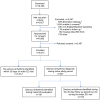ECG Predictors of Cardiac Arrhythmias in Older Adults With Syncope
- PMID: 29275946
- PMCID: PMC5866177
- DOI: 10.1016/j.annemergmed.2017.11.014
ECG Predictors of Cardiac Arrhythmias in Older Adults With Syncope
Abstract
Study objective: Cardiac arrhythmia is a life-threatening condition in older adults who present to the emergency department (ED) with syncope. Previous work suggests the initial ED ECG can predict arrhythmia risk; however, specific ECG predictors have been variably specified. Our objective is to identify specific ECG abnormalities predictive of 30-day serious cardiac arrhythmias in older adults presenting to the ED with syncope.
Methods: We conducted a prospective, observational study at 11 EDs in adults aged 60 years or older who presented with syncope or near syncope. We excluded patients with a serious cardiac arrhythmia diagnosed during the ED evaluation from the primary analysis. The outcome was occurrence of 30-day serous cardiac arrhythmia. The exposure variables were predefined ECG abnormalities. Independent predictors were identified through multivariate logistic regression. The sensitivities and specificities of any predefined ECG abnormality and any ECG abnormality identified on adjusted analysis to predict 30-day serious cardiac arrhythmia were also calculated.
Results: After exclusion of 197 patients (5.5%; 95% confidence interval [CI] 4.7% to 6.2%) with serious cardiac arrhythmias in the ED, the study cohort included 3,416 patients. Of these, 104 patients (3.0%; 95% CI 2.5% to 3.7%) had a serious cardiac arrhythmia within 30 days from the index ED visit (median time to diagnosis 2 days [interquartile range 1 to 5 days]). The presence of nonsinus rhythm, multiple premature ventricular conductions, short PR interval, first-degree atrioventricular block, complete left bundle branch block, and Q wave/T wave/ST-segment abnormalities consistent with acute or chronic ischemia on the initial ED ECG increased the risk for a 30-day serious cardiac arrhythmia. This combination of ECG abnormalities had a similar sensitivity in predicting 30-day serious cardiac arrhythmia compared with any ECG abnormality (76.9% [95% CI 67.6% to 84.6%] versus 77.9% [95% CI 68.7% to 85.4%]) and was more specific (55.1% [95% CI 53.4% to 56.8%] versus 46.6% [95% CI 44.9% to 48.3%]).
Conclusion: In older ED adults with syncope, approximately 3% receive a diagnosis of a serious cardiac arrhythmia not recognized on initial ED evaluation. The presence of specific abnormalities on the initial ED ECG increased the risk for 30-day serious cardiac arrhythmias.
Trial registration: ClinicalTrials.gov NCT01802398.
Copyright © 2017 American College of Emergency Physicians. Published by Elsevier Inc. All rights reserved.
Conflict of interest statement
None
Figures
Comment in
-
The Risk of Thirty-Day Serious Dysrhythmia in Elderly Patients With Syncope or Near Syncope.Ann Emerg Med. 2018 Jul;72(1):107-108. doi: 10.1016/j.annemergmed.2018.02.028. Ann Emerg Med. 2018. PMID: 29929650 No abstract available.
-
In reply.Ann Emerg Med. 2018 Jul;72(1):108-109. doi: 10.1016/j.annemergmed.2018.02.027. Ann Emerg Med. 2018. PMID: 29929651 No abstract available.
References
-
- Sun BC, Emond JA, Camargo CA., Jr Characteristics and admission patterns of patients presenting with syncope to U.S. emergency departments, 1992–2000. Acad Emerg Med. 2004;11(10):1029–1034. - PubMed
-
- Soteriades ES, Evans JC, Larson MG, et al. Incidence and prognosis of syncope. N Engl J Med. 2002;347(12):878–885. - PubMed
-
- Olshansky B, Poole JE, Johnson G, et al. Syncope predicts the outcome of cardiomyopathy patients: analysis of the SCD-HeFT study. J Am Coll Cardiol. 2008;51(13):1277–1282. - PubMed
Publication types
MeSH terms
Associated data
Grants and funding
LinkOut - more resources
Full Text Sources
Other Literature Sources
Medical
Research Materials


